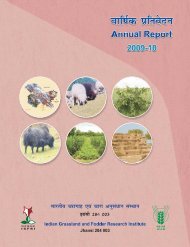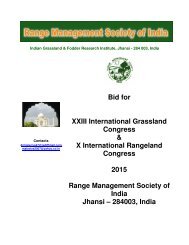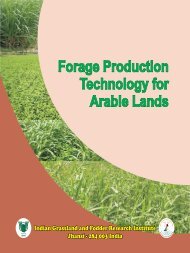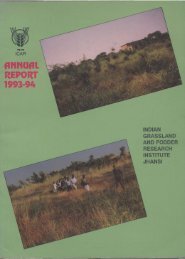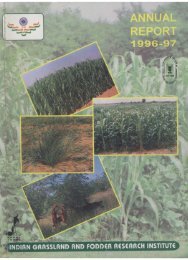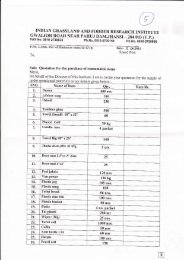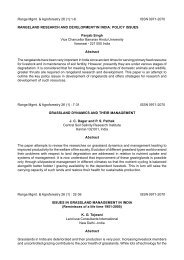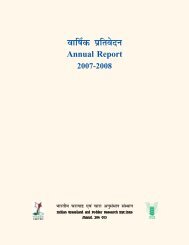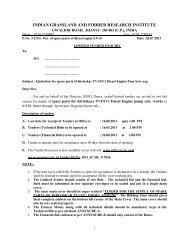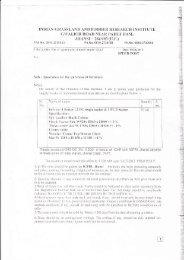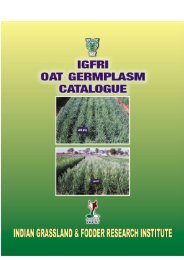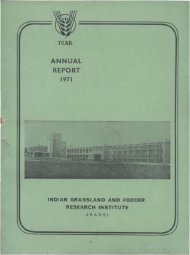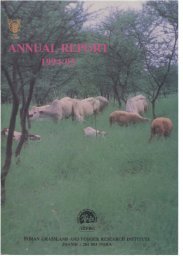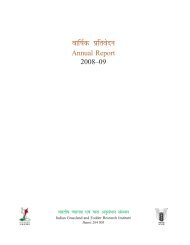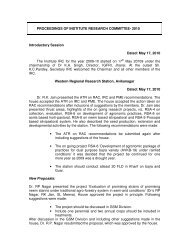IGFRI Vision 2050 - Indian Grassland and Fodder Research Institute ...
IGFRI Vision 2050 - Indian Grassland and Fodder Research Institute ...
IGFRI Vision 2050 - Indian Grassland and Fodder Research Institute ...
You also want an ePaper? Increase the reach of your titles
YUMPU automatically turns print PDFs into web optimized ePapers that Google loves.
<strong>Indian</strong> <strong>Grassl<strong>and</strong></strong> <strong>and</strong> <strong>Fodder</strong> <strong>Research</strong> <strong>Institute</strong><br />
There is need for improvement of nutritional quality of available monsoon<br />
forage resources through protein <strong>and</strong> mineral supplementation as per mineral<br />
map available from NIANP institute (ICAR). There is need to conserve excess<br />
biomass of monsoon for lean period during winter <strong>and</strong> summer. Available Crop<br />
residue consisting largely of paddy straw having high lignin, high silica <strong>and</strong><br />
anti-nutritional oxalate, needs to be improved through various post-harvest<br />
technologies.<br />
Forage production should be encouraged through milk cooperatives during<br />
rabi <strong>and</strong> summer. Activities of fodder tree plantation should be enhanced onfarm<br />
<strong>and</strong> under social forestry, Joint Forest Management (JFM) <strong>and</strong> other<br />
development programmes.<br />
There is need of technologies for utilization of byproducts of vegetable, fruits<br />
<strong>and</strong> edible aquatic biomass (para grass, jalkumbhi, karmi etc.).<br />
6.15 Coping with natural calamities<br />
a. Measures to mitigate drought situation<br />
In the event of any disaster, especially drought that prolongs for much a larger<br />
duration, there is a great concern for fodder. The system should ensure<br />
adequate fodder supplies during the disasters through a concept of <strong>Fodder</strong><br />
Bank at village Panchayat. <strong>IGFRI</strong>/SAUs/ICAR can provide technological<br />
advice whereas state government agencies should ensure availability of seed/<br />
feed/fodder.<br />
b. Measures to mitigate flood situation<br />
Out of the total geographical area of 329 m ha in the country, more than 40 m<br />
ha is prone to flood. The flood prone 33.5 m ha area houses 19.6 m cattle, 1.0 m<br />
buffalo, 6.0 m sheep <strong>and</strong> 13.1 m goats. Taking into account this figure, it has been<br />
estimated that annually, 0.43 m cattle, 0.23 m buffalo, 1.4 m sheep <strong>and</strong> 2.9 m<br />
goats are affected by flood for which contingency plan need to be made.<br />
<strong>IGFRI</strong>/SAUs/ICAR can provide technological advice whereas state<br />
government agencies should ensure availability of seed/ feed/fodder.<br />
6.16 Appropriate measures/decision on policy related issues<br />
Increased investment in forage resource development through credit facility<br />
for fodder <strong>and</strong> fodder seed production <strong>and</strong> its marketing is required. Central<br />
Variety Release Committee (CVRC) should consider straw yield <strong>and</strong><br />
proximate analysis for feeding quality as one of the parameter for release of<br />
food crop varieties in order to assess the nutritional value of crop residues of<br />
newly released food crop varieties. National seed reserve, support price for<br />
forage, marketing of the seed <strong>and</strong> quality seed production protocols needs to<br />
be legislated.<br />
24



